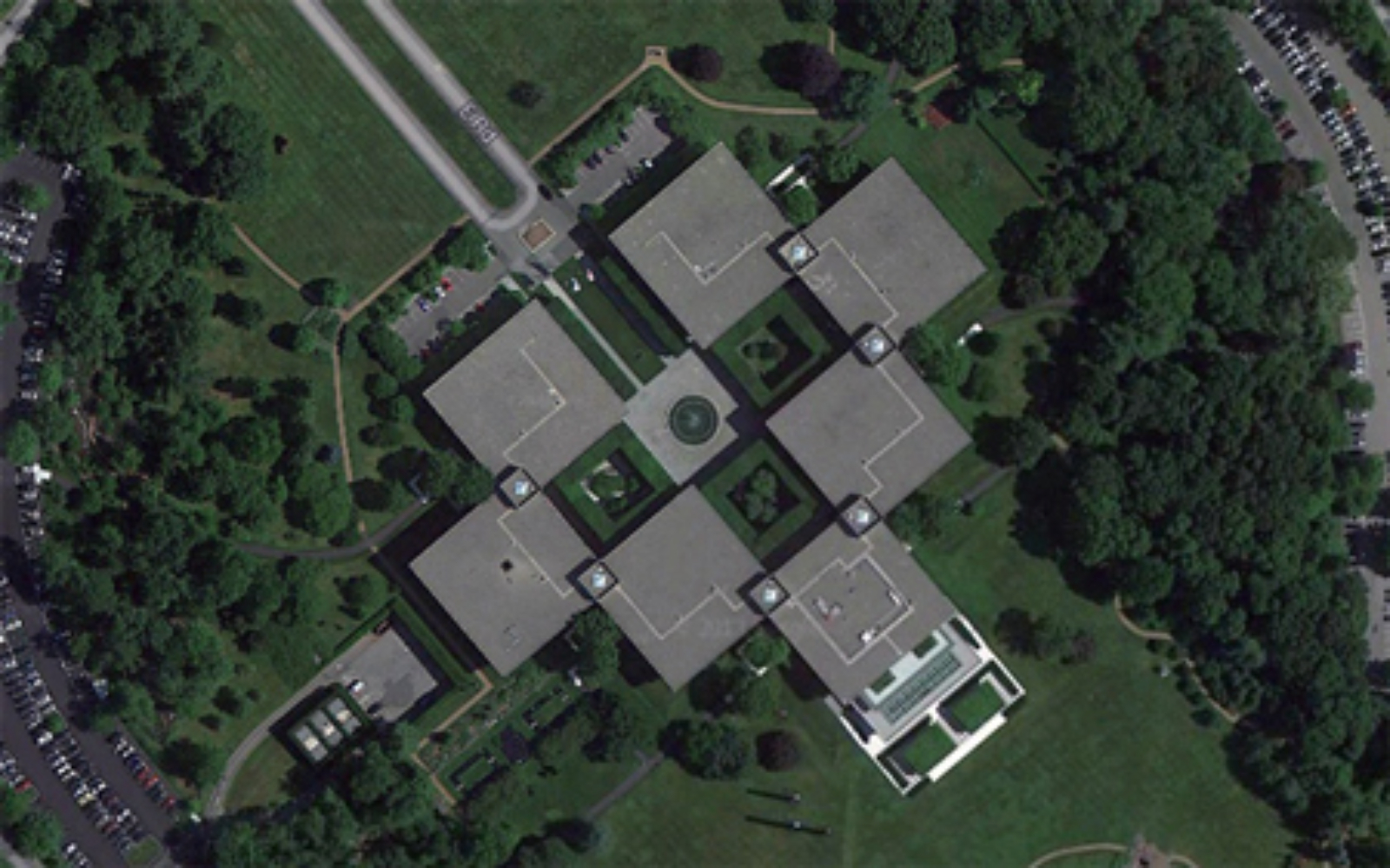 By Jimmy Stamp
By Jimmy Stamp
The corporate campus for PepsiCo, designed by Edward Durell Stone, has served as the company's world headquarters since their move to the suburbs in 1967. After an estimated $243 million dollar renovation beginning in 2013, and despite company-wide downsizing, the campus continues to exist as it was originally designed despite the national trend of corporations moving back to city-centers.
The article below examines the events surrounding Pepsi's decision to move from its New York City headquarters and the influences that defined Stone's iconic design. A version of this article originally appeared on Smithsonian.com (September 2013)
An aerial view of the PepsiCo World Headquarters in Purchase, NY. Credit: Google Maps
In 1967, just a few years before the opening salvo of the Cola Wars, Pepsi left their Park Avenue address for a 450,000-sq-ft complex on a 168-acre former polo field in Purchase, New York. They were joining a diaspora of American corporations fleeing their urban high-rises for sprawling corporate campuses in the greener pastures of the suburbs. To design their new home, Pepsi recruited “modernism’s populist architect” Edward Durell Stone (1902-1978).1

Stone’s design for the American Embassy in New Delhi helped launch him to stardom Credit: Wikicommons
Considering that he was once one of the most famous architects in the world, Stone probably isn’t as well known today as he should be. He first made a name for himself in the 1930s as a promising young designer working on Rockefeller Center and Radio City Music Hall, which led to him, in association with Philip Goodwin (1885-1958), earning the commission for the new Museum of Modern Art building, completed in 1939. Despite his ostensibly International Style practice, Stone had a great appreciation for ornament and vernacular architecture that he gained while traveling through Europe and North Africa on a Rotch Scholarship in the 1920s. These feelings led him to search for a more authentic American architecture and, in 1940, to a lifelong friendship with like-minded searcher Frank Lloyd Wright, who would have a profound influence on Stone. Throughout the following decade Stone continued to work in a Wright-inflected modernist idiom while also serving as chief critic at the Yale School of Architecture and, increasingly as one of the chief critics of the austere brand of modernism practiced by architects like Bunshaft. Wright’s influence would manifest dramatically in the early 1950s when Stone was commissioned to design the American Embassy in New Delhi.
The embassy’s modern design drew equal parts inspiration from Classical temples, European modernism, and local traditions. Its most notable–and most controversial– feature was a patterned concrete screen that minimized heat and glare while still allowing plenty of light into the building. The embassy was met with wide acclaim and honored by the American Institute of Architects as an expression of “serenity and power in government in terms appropriate for the country in which it is guest.” Although the building was an enormous professional and popular success, it proved to be quite divisive among the architectural community. While commissions were pouring into his office, staunch modernists and architecture critics focused on the patterned screen, calling it distracting and decorative – a stigma that would follow Stone throughout the rest of his career. But Stone had developed a fondness for decorative details and clients were clamoring for his ornamental, romantic modernism. With the success of the embassy and a new PR-savvy wife, Stone was quickly propelled from relative obscurity to the cover of Time magazine in 1958. He was, in many ways, the proto-starchitect.
By the time Stone was commissioned to design a new corporate headquarters for Pepsi in the late 1960s, his star was fading. He had finally abandoned concrete grillwork that had defined his personal style for so long, but the buildings behind the screens just weren’t as exciting. He had not, however, abandoned ornament, as evidenced by his design for the Pepsi Headquarters.
New Headquarters
The Purchase, New York complex, which is still the home of PepsiCo, consists of seven nearly identical inverted white ziggurat-like structures clad in alternating stacks of glass and patterned concrete, linked at their corners, and organized around a cruciform central garden. It was supposedly designed to be expanded as the company grew, in a manner similar to Eero Saarinen’s design for IBM’s Rochester facility.

A view from the approach to Pepsi’s Purchase, New York Headquarters. Credit: “WhisperToMe” via wikimedia commons
The new headquarters met with mixed reviews. Architectural Record described it as a “skillful blending” of architecture and nature combining elements of both the urban and the rural.2Pepsi reported that after moving into the building, employee morale went up and work habits had improved. However, many critics still had a hard time accepting Stone’s work. Paul Goldberger, during his tenure as The New York Times architecture critic, called it “a world of utter blandness” that “is free of major vulgarities but also free of any excitement.”3Much of the rancor towards his architecture can probably be attributed Goldberger’s precursor at The Times, the venerable Ada Louise Huxtable, whose dislike of Stone’s work merited two paragraphs in her obituary.4
The landscaping, on the other hand, has been widely lauded. Initially designed by Stone’s son Edward Stone Jr. to complement his father’s structure, the PepsiCo property is a verdant, luxurious sculpture garden filled with work by the likes of Brancusi, Alexander Calder, and Claes Oldenburg. And best of all, it’s open to the public.
Edward Durell Stone retired from practice in 1974 and fell into relative obscurity – a surprising reversal of fortune for a man whose face once adorned the cover of Time. Though his name is in the history books for his early work on Rockefeller Center and MOMA, his later projects do not receive as much attention. Perhaps it's because they’re not as easy to discuss; Stone’s work defies categorization.

View of landscape and sculpture at PepsiCo. Credit: Peter Bond
Notes
